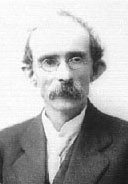Monday, April 10, 2006
The seven signatories - Thomas Clarke
 "This is the beginning, our fight has saved Ireland. The soldiers of tomorrow will finish the task."
"This is the beginning, our fight has saved Ireland. The soldiers of tomorrow will finish the task."Thomas Clarke, May 1916
Continuing United Irelander's focus on the seven signatories of the Proclamation of the Republic while we count down to the military parade this Sunday, today I will take a look at the spider at the heart of the Fenian web, Thomas Clarke.
Born on the Isle of Wight in 1857 to a Leitrim man and a Tipperary woman, his parents eventually settled in Dungannon, Co. Tyrone.
Clarke was a member of the Irish Republican Brotherhood from the age of 18. When he turned 21 he emigrated to America where he took a position as an explosives operative during construction work on Staten Island.
Recognising the value of his knowledge of explosives, he was sent to London in 1883 to put his skills to use however he was captured with a case of liquid explosives and spent fifteen years in Pentonville Prison. Upon his release he married Kathleen Daly, a niece of his old cell mate, John Daly, the Mayor of Limerick. The couple soon emigrated to America before returning to Dublin in 1907 where he opened a tobacco shop in Great Britian Street, nowadays Parnell Street.
Clarke once again immersed himself in the IRB which was undergoing a rejuvenation under the guidance of younger men like Bulmer Hobson and Denis McCullough. Clarke developed a close friendship with Bulmer Hobson who, along with Sean MacDiarmada, became his protegé, however Clarke fell out with Hobson in 1913 when John Redmond, leader of the Irish Parliamentary Party, demanded equal control of the Irish Volunteers. Most of the IRB hard-liners opposed this but the decree was accepted, partially due to the support given by Hobson. Clarke angrily asked Hobson, "What did the castle pay you?", a terrible accusation and the two men never spoke informally again. Hobson resigned from the IRB Supreme Council and was sacked by John Devoy as a contributor to Gaelic American which was his main source of income.
After falling out with Hobson, Clarke and MacDiarmada bcame almost inseparable and the two of them de facto ran the IRB. In 1915 Clarke and MacDermott established the Military Committee of the IRB to plan what later became the Easter Rising. The members were Pearse, Ceannt, and Joseph Plunkett, with Clarke and MacDermott adding themselves shortly thereafter. When an agreement was reached with James Connolly and the Irish Citizen Army in January, 1916, Connolly was also included on the committee. Thomas MacDonagh was added at the last minute in April.
These seven men were the signatories of the Proclamation of the Republic, with Clarke as the first signatory being the oldest and most respected member of the Military Council. It has been said that Clarke indeed would have been the declared President and Commander-in-chief, but he refused any military rank and such honours, which were given to Pearse, who was more well-known and respected on a national level. With that being said, Tom Clarke's widow always maintained that Clarke had indeed become President, and this would have followed standard IRB thinking.
Clarke was stationed in the headquarters at the GPO during the Easter Rising where command of the rebel forces was largely under Connolly. Following the surrender on April 29, Clarke was held in Kilmainham Gaol until he was executed by firing squad on May 3rd. Clarke was the oldest of the leaders to be shot at the age of 59.
It is said that the largest file in Dublin Castle was marked 'Tom Clarke' and the British probably recognised his importance seeing as Clarke was the second leader to be shot on 3 May, immediately after Padraig Pearse.
This Sunday let us pay tribute to this brave hero.
© 2008 United Irelander.

